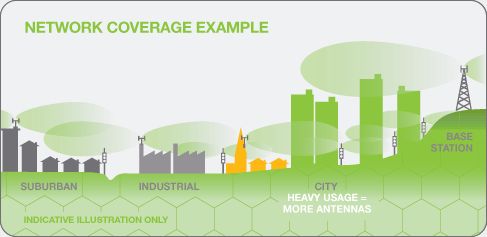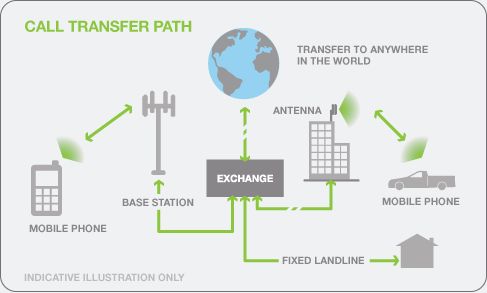Overview
Mobile phones work by sending and receiving low power radio signals. The signals are sent to and received from antennas that are attached to radio transmitters and receivers, commonly referred to as mobile phone base stations. The base stations are linked to the rest of the mobile and fixed phone networks and pass the signal/call on into those networks.
What happens when I make a call from my mobile phone?
The first step in the process is for the phone to check that there is coverage in the area that the call is made. Once the phone has verified that there is sufficient signal strength to make the call, the phone establishes a connection with a nearby mobile phone base station. This base station then establishes the call and holds the call as long as the phone user remains on the call and in the range of that base station.
What is a mobile phone base station?
A mobile phone base station provides coverage to a geographic area known as a “cell”. Cells are aligned next to each other in a similar pattern to a honeycomb, and it is for this reason that mobile phone networks are sometimes referred to as “cellular” networks.
The location of the base station within the cell is determined by a number of factors, including topography and other physical constraints such as trees and buildings, the cell ‘capacity’ or number of calls expected to be made in the cell, and the radio frequency at which the base station will operate.
Topography and physical constraints
In essence, a mobile phone needs to have ‘sight’ of a mobile phone base station. In other words, the radio signal from the phone to the base station needs to be uninterrupted. Hills, trees and tall buildings can obscure this line of sight and so base stations need to be very carefully located to maximize the coverage available.

Mobile Network Cell capacity
Each base station can only carry a finite number of calls. In areas of high mobile phone use, such as central business districts and high density areas, more base stations are required to handle the level of call traffic. In high use areas, there are often a range of base stations, from very specific in-building solutions (designed to give quality coverage within a specific building), to very small base stations known as ‘microcells’. Microcells cover a small geographic area and are often found at intersections and in heavy pedestrian traffic areas.
In rural areas, or areas where mobile phone use is not as high, base stations will often be located on hills or tall structures to maximize the coverage area.
Radio frequency channel allocation
Each base station has a number of radio channels, or frequencies, to communicate with mobile phones. Because this number of frequencies is limited, frequencies are often reused in adjoining cells. This is achieved by reducing the power level of the base station to ensure that there is minimal or no overlap of the coverage between cells.
How does it work if I am moving around?
Calls can be transferred from one base station to another. As you move out of the cell, the phone will automatically look for signal from an adjoining base station. There is usually a smooth transition or ‘handover’ from cell to cell. During the duration of a call, the phone may have handed over to and from a number of base stations. If there is no adjoining base station, such as on the fringes of the mobile phone network, the call will drop.
What does a base station do?
A base station connects the call in to the fixed line network. Depending on the type of call, it will be directed to either another mobile phone or to a fixed line phone. A base station is made up of antennas connected by cable to electronic (radio) equipment usually housed in a room or ‘shelter’. Some base stations have radio communications dishes (shaped like a drum) that connect the base station to the rest of the base station network.

What are 2G,3G & 4G networks?
3G, or third generation networks and 4G, or fourth generation networks operate in a different way to 2G networks. When a call is made on 2G, a line is held open for the user’s conversation throughout the duration of the call. With 3G/4G networks, the data sent across them is divided up into little ‘data packets’ which are reassembled in the correct order at the receiving end. This smart encoding means more data can be sent and it is sent more efficiently. In addition, 3G/4G handsets can be in contact with more than one base station at a time and this provides improved performances in voice quality and data rates. Some people call 3G/4G “mobile broadband” because the evolution is similar to the difference between dial up Internet and the always available broadband Internet services.











